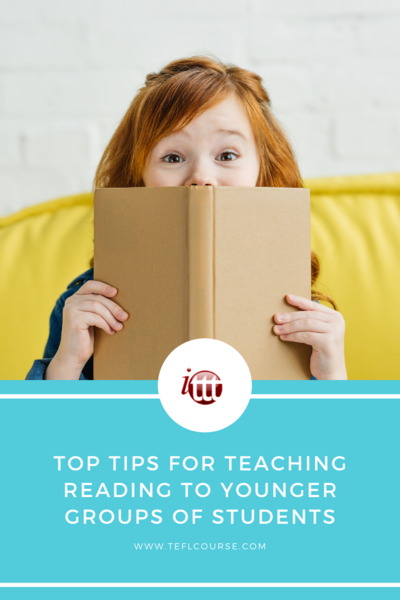Top Tips for Teaching Reading to Younger Groups of Students

There are four basic skills in any language: receptive skills – reading and listening, and productive skills – speaking and writing. Usually, when we learn a new language, we tend to access our learning process and result by checking how our productive skills are and forget that before we can the product, we need to receive first. Data says that the production of every 100 words in writing needs a receipt of 1000 words in reading which means to be able to produce anything, one must get as much as 10 times receipt. Similarly in listening and speaking.
Table of Contents
Receptive Skills: Writing vs. Reading
Do you want to teach English abroad? Take a TEFL course!
This post was written by our TEFL certification graduate Josephine L. Please note that this blog post might not necessarily represent the beliefs or opinions of ITTT.
Receptive Skills: Writing vs. Reading
However, if we compare the efficiency in the two receptive skills - reading and writing, we will get that the words we could go through in each minute in reading are a lot more than we can in listening. Besides, it is much easier for a student to hold a book and get to know the world than to go around the world and talk to people about everything he wants to know. And that makes reading the key to grasping a language.
Reading falls into intensive reading and extensive reading. Both are equally important for learning a new language. People read extensively to review the language as well as gain new knowledge while they read intensively, usually in class, forgoing deeper in that language or subject. Teaching young learners, they are both important in the process of learning a new language. Though how do we do it with children who barely know the target language yet?

The answer is: using picture books and leveled reading. With the popularity of picture books from Japan and leveled reading from the West, teachers now can import language with a story that has a huge beautiful illustration that almost no child would reject. By reading and learning to read these pretty books both intensively and extensively, the grow of imaginations happens along with deep thinking in the target language. After that happens, we get them to share their thoughts and that's when speaking is encouraged. After eliciting new and personal ideas from the topic in that book, teachers get their students to draw or write it on the paper to have them an early taste of a print made by themselvesï¼All is so exciting already yet there's moreï¼There have already been a lot methodology and practice that we could learn and use from our predecessors. Here below I will list some of them:
Also Read: Can I teach English as a foreign language online?
Decoding
Before skip, scam and all those other reading skills happen, our young learners need to learn how to read which with English is to decode the letters into sounds and put them back together. Teaching them phonics systematically helps with that. Along with decoding, the concept of rhyme and others in phonology can be taught too.
Reading aloud for fluency
With the teaching of phonics, children get to read, then their reading fluency starts to matter since without decoding fast and reading fluently enough, children hardly can start paying attention to the concept of which they are reading. Ask them to teachers, to parents, to each other and themselves and insist on doing that would help in the long run.

Also Read: Do TEFL certificates expire?
Learning how to read close
As long as children have formed the habit of reading, they are then able to read everywhere with everyone. Equipping them with close reading skills become essential. When we do a close read, we read the text three times with different reading goals. In the first read, students should get the gist and answer the question: What does the text say? In the second read, they dig a little deeper drawing marks on the book to find out new words, connections, questions, etc. They also should answer the question: How does the text say it? In the third read, they put all together with the information they find in the text and draw a thinking map. Now they answer the question: What does the text mean? While students go through the procedure several times in the classroom, they should be able to transfer the method into self-reading then they can read to know the world anytime!
Do you want to teach English abroad? Take a TEFL course!
Apply now & get certified to teach english abroad!
Speak with an ITTT advisor today to put together your personal plan for teaching English abroad.
Send us an email or call us toll-free at 1-800-490-0531 to speak with an ITTT advisor today.
Related Articles:
- Differences between Young Learners and Adult Learners in the TEFL Environment
- How Learning A Foreign Language Made Me a Better ESL Teacher
- The 5 Best Places to Learn French When Teaching English Abroad
- Top 5 Skills Teachers Need To Set Their Students Up For Success
- 4 Super Easy Tips for Teaching Vocabulary to Young Learners
- All the Documents You Will Need to Teach English Abroad




